Pet First Aid Programs Grow in Popularity
By Alexandra Paez
Photography By Emree Weaver
Reporting Texas
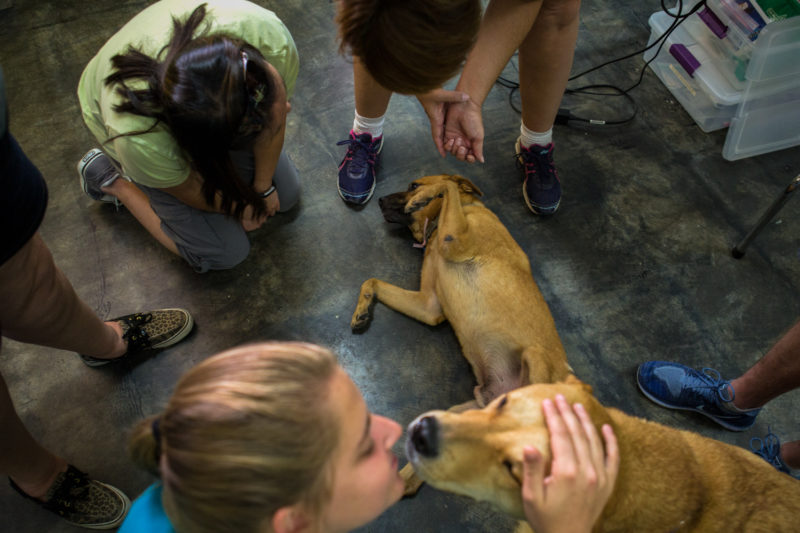
A pet first aid class gathers to practice taking vital signs on instructor Sonya Wilson’s two dogs, Rex and Concord. Emree Weaver/Reporting Texas
Four students huddled around Sonya Wilson, a tall, no-nonsense instructor, as she hunched over the patient and searched for a pulse.
As Wilson moved on to a nose-to-toes assessment, one of her students took her turn trying to locate a pulse. Rex rolled over and stretched out his arms and legs. The young woman poked his armpit.
“I found it,” the student told the instructor.
“Give him a treat,” Wilson said.
Rex, a 9-year-old male mixed breed, has been Wilson’s loyal assistant for her pet first aid courses, Four Legged First Aid, since 2010. Pet first aid is any type of emergency care given to an animal before it can receive more comprehensive medical care from a veterinarian. The training, which focuses on dogs and cats, has grown in popularity recently. Since 2013, the number of National Association of Professional Pet Sitters members who have completed the certification has tripled. And Wilson said that since she first marketed to pet professionals, almost all her classes have been full.
“There’s been a significant increase in at least the last 5 years,” said Humane Educators of Texas pet safety instructor Kelly Thyssen.
Pet first aid is similar to first aid for humans. The main differences are anatomy and the animal’s inability to communicate a problem. Wilson’s dogs are invaluable to her class. Concord, a 5-year-old female and also a mutt, joined Wilson and Rex a year ago. Together, the two dogs are referred to as the “Texas Road Dogs.” Concord is still in training, but she will sit for students so they can practice putting a muzzle on her.
For CPR demonstrations and practice, Wilson uses her “doggyquin,” a dog mannequin. Much of pet first aid is knowing what is normal for your animal and recognizing the signs that something is wrong. The class covers many topics, such as signs of serious illness, accident prevention, CPR and the Heimlich maneuver – for four-legged animals, of course.
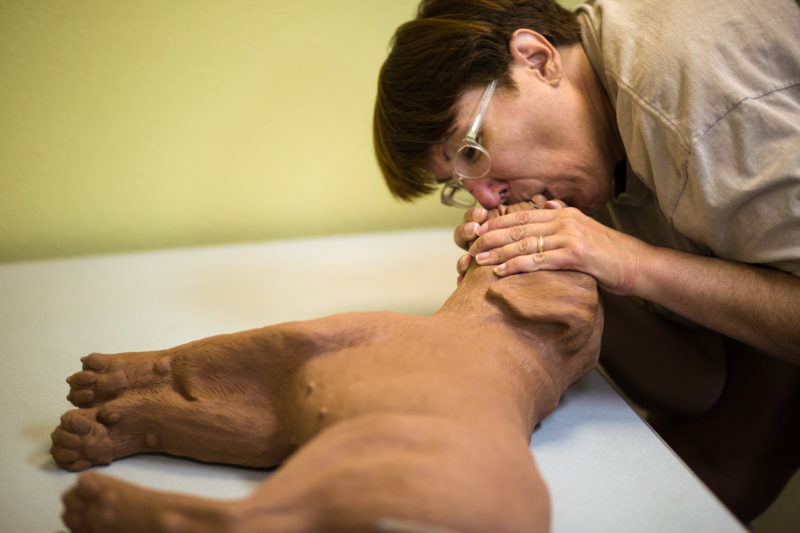
Wilson demonstrates administering CPR using what she calls a “doggyquin.” Emree Weaver/Reporting Texas
Wilson and her husband, Tim Smith, have run their own dog day care, Southpaws Playschool, since 2002. For the past seven years, she has been teaching her pet first aid course, a program that was inspired by a near-death incident with one of her dogs. Wilson’s two dogs got tangled up, with one’s snout trapped under the other’s collar. While the one dog tried to free its snout, the other stopped breathing. Wilson didn’t know what to do. Instinctively, she began to pound on her dog’s chest hoping it would start breathing again.
“I accidentally did what was right, but I wanted to be sure that I would actually know what to do in emergency situations like that,” Wilson said.
She estimated that she has taught several hundred students and offers the four-hour class about twice a month. In her class, Wilson stresses the importance of disaster preparedness, such as having on hand a first aid kit, medications and food and water.
Wilson also emphasizes the importance of taking animals to a veterinarian after performing basic first aid.
“There is a lot of information that I know that I don’t tell students so they will have to go to the vet,” Wilson said.
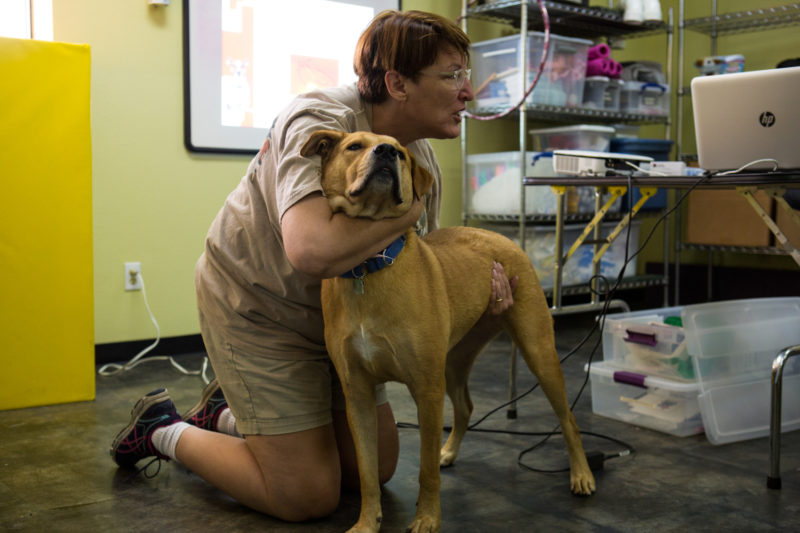
Sonya Wilson shows her class how to restrain a dog. Restraint is the first and most important step when a dog has a medical emergency. Emree Weaver/Reporting Texas
Four Legged First Aid is one of the few hands-on, in-person pet first aid classes in the Austin area. Wilson updates information in her course every year by taking online pet first-aid courses and reading veterinary journals. She is also the author of “Hairy Situations: Crisis Planning, Response and Recovery for Your Pet Business.”
There are other options for those who are interested in learning more about pet first aid courses. Pet Tech, based in California with Central Texas locations, offers pet first aid courses as well as courses for people who want to teach pet first aid.
One of Pet Tech’s instructors, Kelly Thyssen, owns Humane Educators of Texas, located in Pflugerville. She covers CPR and first aid as part of Pet Tech’s pet safety course. Like Wilson, she teaches classes for animal control officers, shelter workers, pet sitters, dog walkers and pet owners.
“The benefit of training is that in the time of crisis, you revert to what you have been trained to do,” Thyssen said. “Pet CPR and first aid training provides animal care workers with the knowledge and hands-on skills to be calm in crisis and provide the fastest and best care they can and hopefully save a life.”
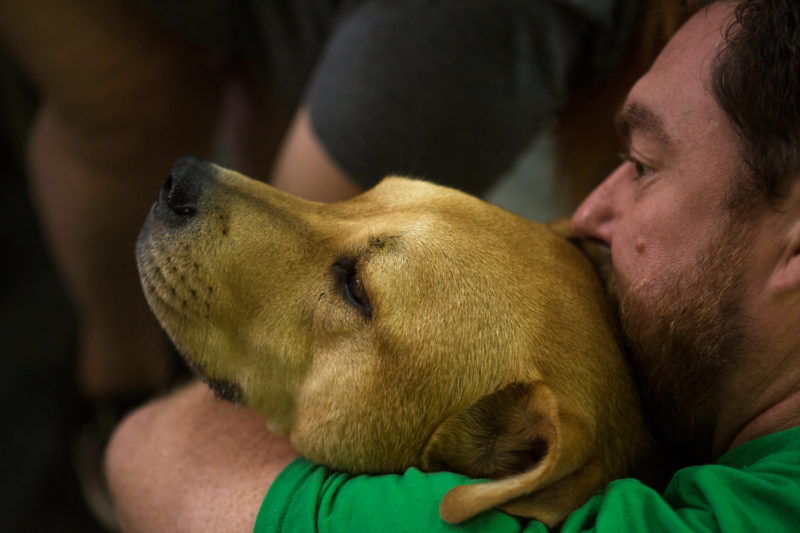
One of the students practicing restraining Wilson’s dog, Concord. Emree Weaver/Reporting Texas
Other programs are available online through the Federal Emergency Management Administration and the Red Cross but do not offer any hands-on training. The Red Cross also offers a free app that gives quick access to emergency information such as the location of the nearest animal hospital and step-by-step first aid instructions.
Humane Educators of Texas, which seeks to change the public perception of animal control officers from dog catchers to professionals who are a resource for people with pets, has five pet first aid classes scheduled through January.
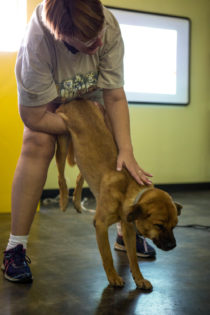
Wilson demonstrates how to treat a dog that is choking. Reporting Texas
“People are becoming more aware pet owners,” Thyssen said. “There is a higher interest in animal facilities becoming well-trained to provide the best care they can.”
The National Association of Professional Pet Sitters has seen an increase of members with first aid certifications over the past five years. NAPPS offers certification through the American Red Cross pet first aid course. About one third of its members has taken the course.
“Anything can happen, but you can’t call doggy 911 to come and help your pet,” said Yvette Gonzales, president of NAPPS. “Pet first aid is one of the things that sets professional pet sitters apart from hobby pet sitters.”
Pet professionals should take the time to learn first aid and disaster preparedness, and owners should make sure to select pet sitters with the proper training, Wilson said.
“It is better to be prepared than to be unprepared and regret it.”